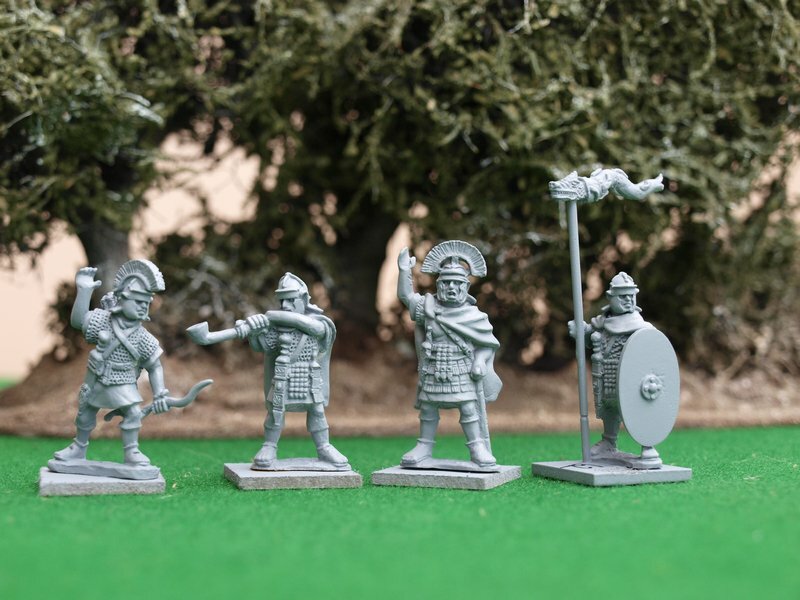- This topic has 7 replies, 3 voices, and was last updated 3 years, 5 months ago by
Alan Hamilton.
-
AuthorPosts
-
07/11/2020 at 21:07 #146488
Alan Hamilton
ParticipantI am naming my Romans after the units on Antonine’s Wall or in Caledonia.
I am about to raise the Auxilliary Cohort I Hamiorum Sagittariorum (Syrians) and for their command group I am in a quandary. Should I give them a vexillum, signum or draco? Aventine miniatures give their Early Imperial archer command groups a draco.
I suspect that the answer is “We don’t know”. So does anyone else give their EIR archers a draco as the unit standard?
08/11/2020 at 13:46 #146514 Thaddeus BlanchetteParticipant
Thaddeus BlanchetteParticipantI do, but mine are fantasy.
I take the attitude that all my historical games actually occur in a parallel dimension, one point removed from ours. So when I want to make changes like this, I just go ahead and do it.
My rule is this: can I come up with a plausible hypothesis that it looked like that? Better yet, is there at least some circumstantial evidence in support of it? If so, I do it and don’t look back.
As such, my EIR legions have small groups of skirmishing javelineers. The two periods before and after did and there is some circumstantial evidence than legionaires were told off for this role. It makes the legions look better and fight better, so I did it.
We get slapped around, but we have a good time!
08/11/2020 at 14:28 #146515 Mike HeaddenParticipant
Mike HeaddenParticipantThe EIR cohort (legionary or auxiliary) carried a signum.
Vexilla (“little sails”) were normally used for detached parts of a larger formation, usually detached parts of a legion.
The Draco seems to have started as a cavalry standard in the 2nd century (possibly introduced by Sarmatian cavalry) but by the Later Roman Empire was carried by legionary cohorts too.
There are 100 types of people in the world, those who understand binary and those who can work from incomplete data
08/11/2020 at 17:42 #146517Alan Hamilton
ParticipantThanks both.
Thaddeus – I take your point and will certainly think about what you say as some of my games are set in a fictional continent somewhat resembling a cross between real world Europe, Tolkein’s Middle Earth and Conan’s Hyboria with limited magic/superstition and occasional intervention from deities.
Mike – that is pretty much what I thought but the Aventine command packs got me thinking that maybe I had missed something. My Legion is based on the mid 2nd Century around the time that Antoninus Pius ordered the construction of the wall a few miles from where I live.

 09/11/2020 at 02:03 #146528
09/11/2020 at 02:03 #146528 Mike HeaddenParticipant
Mike HeaddenParticipantBoth the standard and the alpenhorn look a little odd for an EIR Roman unit.
Musical instruments in the Roman army at that point should look like this:

Troops shown are a tubicen, with a tuba, on the right and a cornicen, with a cornu, on the left.
Which is not at all to say you can’t use the figures you have. Just be aware that “caligae counters” may look at them sideways 🙂
There are 100 types of people in the world, those who understand binary and those who can work from incomplete data
09/11/2020 at 10:07 #146556Alan Hamilton
ParticipantBoth the standard and the alpenhorn look a little odd for an EIR Roman unit. Musical instruments in the Roman army at that point should look like this: Troops shown are a tubicen, with a tuba, on the right and a cornicen, with a cornu, on the left. Which is not at all to say you can’t use the figures you have. Just be aware that “caligae counters” may look at them sideways
Thanks, Mike. I did a bit more research on line last night and this morning. (I am away from my books just now.) The “alpenhorn” instrument is a lituus which my references seem to regard as being mainly used in funerals, processions by civilians but also in the army (mainly?) by the cavalry arm. It is based on an old Etruscan instrument. Here is one found near Dusseldorf

So I have an answer to the “caligae counters”.
09/11/2020 at 14:51 #146563 Mike HeaddenParticipant
Mike HeaddenParticipantWell, I’d never seen reference to them being used by the military. Must rummage online.
Thanks for that info Alan.
There are 100 types of people in the world, those who understand binary and those who can work from incomplete data
09/11/2020 at 15:34 #146564Alan Hamilton
ParticipantThere is also an illustration in Peter Connolly’s “Greece and Rome at War” page 237 (probably the same instrument)
And in Bold as brass: ‘brass instruments’ in the Roman army by R Cross – pp 5-6
The lituus, as well as being the curved staff of the augurs, also refers to a curved brass instrument. According to Aulus Gellius, the instrument resembled the aforementioned staff to some degree (Aulus Gellius 5.8). Seneca described the lituus as a bronze instrument with a hooked end (Sen. Oed. 733). A lituus fitting this description, found in the Rhine near Dusseldorf (Figure 3), consists of a conical tube with a curved, flared bell and notably features a set cup-shaped mouthpiece.
There are several learned papers on the internet dealing with musical instruments in the Roman army.
-
AuthorPosts
- You must be logged in to reply to this topic.



